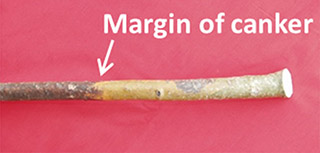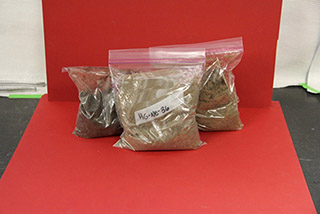G2227
Landscape and Garden Plants Sample Submission to the Plant and Pest Diagnostic Clinic
Diagnoses are made easier and turnaround time is improved when the quality of plant samples is maintained. This NebGuide discusses the proper guidelines for submitting landscape and garden plants, turf, and tree samples to UNL’s Plant and Pest Diagnostic Clinic.
Kevin A. Korus, Extension Educator, Plant Pathology
Tamra A. Jackson-Ziems, Extension Plant Pathologist
James A. Kalisch, Extension Associate, Entomology
Lowell D. Sandell, Extension Educator, Weed Science
Terri L. James, Extension Horticulturalist, Agronomy and Horticulture
- General Guidelines
- Sample Submission
- Nutrient Analysis and/or Chemical Injury
- Plant Samples — For Identification
- Insect Samples for Identification
- Plant Parasitic Nematode Analysis
- Samples from Out of State
General Guidelines
There are several important things to consider when collecting, packaging, and sending plant or insect samples for diagnosis in a plant diagnostic laboratory.
Collect an adequate amount of plant material. When feasible, the sample should include the entire plant — roots, stems, leaves, flowers, and fruits. Whole plants are needed to properly evaluate the sample. If the whole plant is not available, photos of the symptomatic plants can improve accuracy of diagnosis.
Sample Submission
- Samples should be placed in a sealable plastic bag.
- The root ball should be enclosed in a separate bag to prevent soil from contacting the rest of the plant (Figure 1).
- Never add water to the bag.
- Add a dry paper towel(s) to the sample bag.
- Place samples in a sturdy container for shipping.
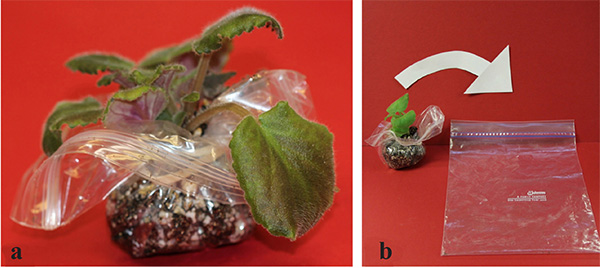 |
Figure 1. a) Enclose roots and soil in a plastic bag, b) then place the sample in a second sealable plastic bag. |
Fruits and Vegetables
- Place fruits and vegetables in a plastic bag, but DO NOT seal it.
- Add padding to the shipping package to prevent bruising.
Trees/Shrubs
|
- For leaf blights, collect branches with distinct symptoms.
- Collect samples from branches that are symptomatic but not dead.
- Include a “healthy” branch without symptoms.
- When possible, include photos of the blighted trees.
- If a canker is present, collect a branch that includes the margin of the canker. This is the area where the discolored bark meets the healthy looking bark (Figure 2).
- Collect stems from blighted area that are at least 3 inches in diameter and 6-8 inches long.
- Include four to six stems.
If pine wilt is suspected:
- from the base of the trunk or from a large limb, collect a wedge-shaped sample 1 inch thick
or - from an infected branch, collect a stem that is at least ½-1 inch in diameter and 6-8 inches long.
Turf
|
- Collect a section of turf 6 inches in diameter and 4-6 inches deep (Figure 3).
- Be sure to dig deep enough to collect a good portion of the root system.
- Sample from the margin of the blighted area, where unhealthy turf meets healthy turf.
Nutrient Analysis and/or Chemical Injury
Please note that the Plant and Pest Diagnostic Clinic is not capable of conducting tissue analysis testing. All diagnoses of nutrient deficiency/toxicity and chemical injury are based on visual observations of the symptoms.
On the sample submission form, provide as much field/site history as possible, including the chemical name and application dates and rates of any fertilizer, seed treatment, herbicide, fungicide, or insecticide applied.
Plant Samples — For Identification
- Collect as many of the plant parts as possible: leaves, stems, flowers, bark, fruit.
- Take a picture of the entire plant if possible.
- Place the plant into a sealable plastic bag with a dry paper towel.
- If possible, keep the plant refrigerated or in a cooler prior to shipping.
- Describe where the plant is located: e.g., full sun, full shade, etc.
Insect Samples for Identification
Soft-bodied specimens (e.g., larvae, aphids, mites, and spiders):
- Place in a tight-sealing bottle with a liquid preservative such as 70 percent alcohol or white vinegar at 5 percent acidity (Figure 4).
Hard-bodied specimens (e.g., beetles, bugs, moths, ants, and flies):
- Wrap in loose tissue and place in a crush-proof container (Figure 5).
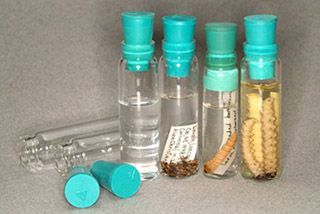 |
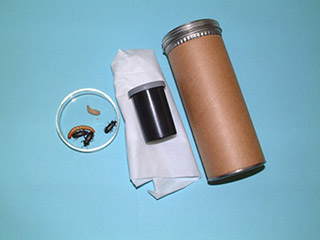 |
|
Figure 4. Soft-bodied specimens in liquid preservative. |
Figure 5. Proper packaging for hard-bodied insect specimens. |
Living specimens (whether soft or hard-bodied):
- Place with the host plant or damaged material along with loose paper tissue into a ventilated container.
Specimens in sticky traps and glue boards:
- Label according to location, put each in a protective bag, and mail in a crush-proof box.
Do not:
- tape specimens to paper.
- place loose insects in envelopes.
- use water or formaldehyde as a preservative.
Plant Parasitic Nematode Analysis
|
Samples from Out of State
Sample submission from outside of Nebraska must follow guidelines set by the United States Animal and Plant Health Inspection Service (APHIS).
If sending any plant sample or soil from outside of Nebraska, contact the University of Nebraska–Lincoln Plant and Pest Diagnostic Clinic at (402-472-2559) to receive further instruction on how to mail the sample.
This publication has been peer reviewed.
Visit the University of Nebraska–Lincoln Extension Publications website for more publications.
Index: Lawn and Garden
Miscellaneous
Issued January 2014
